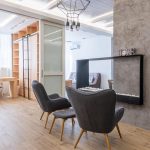If you're dealing with Seasonal Affective Disorder (SAD), desk lamps can make a real difference. These lamps simulate natural sunlight, helping to boost your mood and energy levels during the darker months. Look for models with at least 10,000 lux brightness and a color temperature between 5000K and 6500K for maximum effectiveness. Position it correctly and use it consistently for the best results. Want to discover more tips on choosing the right lamp? Keep exploring!
Table of Contents
Key Takeaways
- Desk lamps designed for SAD should provide at least 10,000 lux to effectively mimic natural sunlight.
- Look for lamps with a color temperature between 5000K to 6500K for optimal daylight simulation.
- Adjustable brightness and settings allow for personalized light therapy sessions tailored to individual needs.
- Position the lamp at eye level, 16 to 24 inches away, and use it for 20 to 30 minutes each morning.
- Ensure the lamp is flicker-free to prevent eye strain during prolonged use.
Understanding Seasonal Affective Disorder (SAD)
If you've ever felt a wave of sadness or lethargy as winter sets in, you might be experiencing Seasonal Affective Disorder (SAD). This condition affects many people, typically surfacing during the colder months when daylight hours are shorter.
You may notice symptoms like low energy, irritability, and changes in sleep patterns. It's not just the winter blues; SAD can significantly impact your daily life. You might find it hard to concentrate or enjoy activities you usually love.
The exact cause isn't fully understood, but it's believed that reduced sunlight can disrupt your body's internal clock and serotonin levels. Recognizing these signs is the first step toward managing your symptoms and seeking help.
You're not alone; many struggle with this seasonal challenge.
How Light Therapy Works
Light therapy is a powerful tool for combating the symptoms of Seasonal Affective Disorder (SAD), especially when the days grow short and dark. By mimicking natural sunlight, these lamps help regulate your body's internal clock, boosting mood and energy levels. When you sit in front of a light therapy lamp, the bright light penetrates your eyes, influencing brain chemicals linked to mood.
Here's a quick overview of how light therapy works:
| Aspect | Description |
|---|---|
| Light Source | Bright, full-spectrum light |
| Duration | Typically 20-60 minutes daily |
| Timing | Best in the morning |
| Effectiveness | Can improve mood and reduce SAD symptoms |
Using light therapy can significantly enhance your well-being during challenging seasons.
Benefits of Using Desk Lamps for SAD
Using desk lamps designed for light therapy can significantly improve your mood and energy levels during the darker months. By exposing yourself to bright light for about 20 to 30 minutes a day, you can help regulate your body's internal clock and combat symptoms of Seasonal Affective Disorder (SAD).
This daily light exposure can enhance your overall well-being, making it easier to concentrate and stay motivated throughout the day. You'll likely notice reduced feelings of fatigue and irritability, which can lead to improved social interactions and productivity.
Additionally, using a desk lamp allows you to create a personal, cozy environment where you can enjoy your favorite activities—whether it's reading, working, or relaxing—while reaping the benefits of light therapy.
Key Features to Consider When Choosing a Desk Lamp
What should you look for when selecting a desk lamp for Seasonal Affective Disorder?
First, consider the lamp's brightness. You'll want one that emits at least 10,000 lux to effectively mimic natural sunlight.
Next, pay attention to the color temperature; a lamp with a color temperature around 5000K to 6500K closely resembles daylight and can help uplift your mood.
Additionally, look for adjustable settings to customize your light exposure as needed.
Portability is another key feature; a lightweight design allows you to easily move it around your workspace.
Finally, ensure the lamp has a flicker-free design to reduce eye strain during prolonged use.
These features will enhance your light therapy experience and provide the relief you need.
Tips for Effective Light Therapy at Your Workspace
To maximize the benefits of light therapy at your workspace, position your desk lamp at eye level and about 16 to 24 inches away from you. This distance ensures that your eyes receive optimal exposure without discomfort.
Use the lamp for about 20 to 30 minutes each day, ideally in the morning to help regulate your circadian rhythm. Ensure the room is dimly lit to enhance the lamp's effectiveness, and avoid placing it in direct sunlight, as this can reduce its impact.
Take breaks during your work to step away from the screen and give your eyes a rest. Lastly, maintain a consistent routine to help your body adjust and reap the full benefits of light therapy over time.
Frequently Asked Questions
Can Desk Lamps Be Used All Year Round for Mood Enhancement?
Absolutely, you can use desk lamps all year round to boost your mood. They provide bright light that can elevate your spirits and energy levels, making your workspace more inviting and enhancing your overall well-being.
How Long Should I Use a Desk Lamp Daily for Best Results?
You should use a desk lamp daily for about 20 to 30 minutes to achieve the best results. Consistency is key, so try to incorporate it into your routine for optimal mood enhancement.
Are There Specific Brands Recommended for SAD Desk Lamps?
When choosing a desk lamp, consider brands like Verilux, Carex, and Philips. They're known for quality and effectiveness. You'll want a lamp that mimics natural sunlight for the best results in improving your mood.
Can Desk Lamps Interfere With Sleep Patterns if Used Late?
Yes, desk lamps can interfere with your sleep patterns if used late. The bright light can disrupt your body's natural circadian rhythm, making it harder for you to fall asleep when you need to.
Is It Safe to Use a Desk Lamp for Children With SAD?
Using a desk lamp for children can be safe, but you should monitor their exposure and ensure it's appropriate for their age. Always consult a healthcare professional to find the best approach for their needs.




